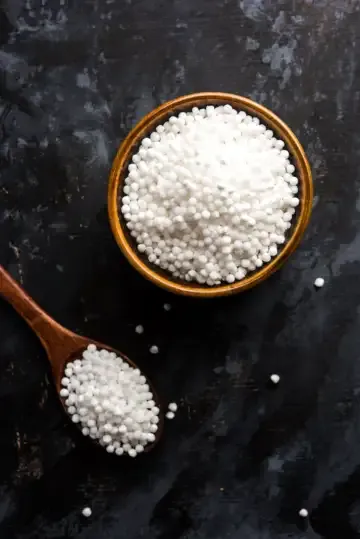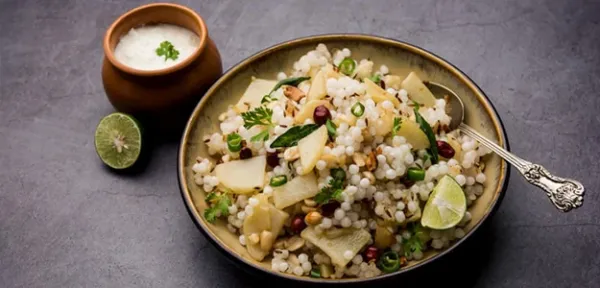It is generally considered "energising" and "easy to digest," which also contributes to its 'vrat-friendly' status. However, some of its benefits are massively overstated, as per experts. So is it still okay for you to consume it? For this, you need to understand exactly what sabudana is made of. Have you ever thought about where it actually comes from? Whether you eat sabudana during your festive fast or otherwise, here's what you need to be aware of:
What Is Sabudana?

Sabudana is made from cassava
Sabudana (also known as pearl tapioca) are small starch pearls. They are made from the starch of the cassava root. Raw sabudana is hard and white. It turns slightly translucent, soft and chewy after cooking. Sabudana provides simple carbohydrates and doesn't have much taste of its own. Thus, it can be infused with a variety of flavours while cooking. Sometimes, the term "sago" is used synonymously for the same ingredient. However, true sago is different from what we consume as sabudana in India.
Sabudana Versus Sago - What's The Difference?
Both sabudana and sago resemble small white balls that become rather translucent after cooking. But they are technically not the same ingredient. Sabudana is made from the starch of the cassava root, while sago is traditionally made from the spongy pith of the sago palm. True palm sago can be found in places like Indonesia, Malaysia, Papua New Guinea, etc. The processing methods for both ingredients have several similarities. But the raw material is different. Nowadays, many brands market sabudana and sago as the same food. But in India, you will mostly find cassava-based sabudana, since it is more widely available and commercially produced within the country.

Sabudana and sago are actually different ingredients
How Is Sabudana Produced?
Here's a detailed breakdown of how sabudana is made from scratch:
- Mature cassava roots are harvested, washed thoroughly and peeled to remove soil, peels and impurities before processing.
- The peeled cassava roots are ground or grated with water until they turn into a soft, wet paste. This helps release the starchy part from inside the root.
- The paste is strained, so the stringy bits of root are taken out. The starchy water is left to settle, and the starch sinks to the bottom. The water on top is poured off, and the starch at the bottom is rinsed a few times to make it clean and pure.
- The clean starch is mixed with hot water until it forms a soft, smooth dough. The heat and water are carefully controlled so it stays workable and doesn't cook too much at this stage.
- The dough is shaped into small round balls (pearls). This can be done by hand, by tossing in cloths, rolling in large rotating pans, or by machines that press and cut the dough into tiny pieces. The method used affects how even the pearls look and how big they are.
- The shaped pearls are then subjected to controlled heat so the outer layer gelatinises and each bead firms up without collapsing. This is what gives it that typical translucent consistency and chewy texture.
- After heat-setting, the pearls are dried in dryers or air tunnels. They are then sieved/sorted into sizes, cooled, and later packaged.
When Was Sabudana Introduced In India?
Cassava was brought to India by the Portuguese in the 1600s. In Kerala, it was popularised as a life-saving crop during a famine in the 19th century. But sabudana, as we know it today, came much later. Its consumption in India is believed to have begun in the 1940s and 1950s. Sabudana-making units were said to have been established in Tamil Nadu around that time. Thereafter, the ingredient spread to different parts of the country and became an ubiquitous part of regional diets. Thus, although sabudana is often called a "traditional" ingredient today, it is actually not as ancient as we may imagine.

Sabudana can be used to make various Indian snacks
Is Sabudana Good For Health? What Nutritionists Have To Say
Many experts have pointed out that sabudana doesn't have many nutrients. It is almost pure starch, with hardly any protein, fibre, vitamin or mineral content. Therefore, consuming only sabudana may not benefit your health. Since it's a simple carbohydrate, nutritionists warn that it can easily spike blood sugar levels. Eating sabudana may give you a quick energy boost, but it mostly doesn't last. Since it lacks fibre and protein, it cannot keep you satiated for a long time.

 Sabudana is made from cassava
Sabudana (also known as pearl tapioca) are small starch pearls. They are made from the starch of the cassava root. Raw sabudana is hard and white. It turns slightly translucent, soft and chewy after cooking. Sabudana provides simple carbohydrates and doesn't have much taste of its own. Thus, it can be infused with a variety of flavours while cooking. Sometimes, the term "sago" is used synonymously for the same ingredient. However, true sago is different from what we consume as sabudana in India.
Sabudana Versus Sago - What's The Difference?
Both sabudana and sago resemble small white balls that become rather translucent after cooking. But they are technically not the same ingredient. Sabudana is made from the starch of the cassava root, while sago is traditionally made from the spongy pith of the sago palm. True palm sago can be found in places like Indonesia, Malaysia, Papua New Guinea, etc. The processing methods for both ingredients have several similarities. But the raw material is different. Nowadays, many brands market sabudana and sago as the same food. But in India, you will mostly find cassava-based sabudana, since it is more widely available and commercially produced within the country.
Sabudana is made from cassava
Sabudana (also known as pearl tapioca) are small starch pearls. They are made from the starch of the cassava root. Raw sabudana is hard and white. It turns slightly translucent, soft and chewy after cooking. Sabudana provides simple carbohydrates and doesn't have much taste of its own. Thus, it can be infused with a variety of flavours while cooking. Sometimes, the term "sago" is used synonymously for the same ingredient. However, true sago is different from what we consume as sabudana in India.
Sabudana Versus Sago - What's The Difference?
Both sabudana and sago resemble small white balls that become rather translucent after cooking. But they are technically not the same ingredient. Sabudana is made from the starch of the cassava root, while sago is traditionally made from the spongy pith of the sago palm. True palm sago can be found in places like Indonesia, Malaysia, Papua New Guinea, etc. The processing methods for both ingredients have several similarities. But the raw material is different. Nowadays, many brands market sabudana and sago as the same food. But in India, you will mostly find cassava-based sabudana, since it is more widely available and commercially produced within the country.
 Sabudana and sago are actually different ingredients
How Is Sabudana Produced?
Here's a detailed breakdown of how sabudana is made from scratch:
Sabudana and sago are actually different ingredients
How Is Sabudana Produced?
Here's a detailed breakdown of how sabudana is made from scratch:
 Sabudana can be used to make various Indian snacks
Is Sabudana Good For Health? What Nutritionists Have To Say
Many experts have pointed out that sabudana doesn't have many nutrients. It is almost pure starch, with hardly any protein, fibre, vitamin or mineral content. Therefore, consuming only sabudana may not benefit your health. Since it's a simple carbohydrate, nutritionists warn that it can easily spike blood sugar levels. Eating sabudana may give you a quick energy boost, but it mostly doesn't last. Since it lacks fibre and protein, it cannot keep you satiated for a long time.
Sabudana can be used to make various Indian snacks
Is Sabudana Good For Health? What Nutritionists Have To Say
Many experts have pointed out that sabudana doesn't have many nutrients. It is almost pure starch, with hardly any protein, fibre, vitamin or mineral content. Therefore, consuming only sabudana may not benefit your health. Since it's a simple carbohydrate, nutritionists warn that it can easily spike blood sugar levels. Eating sabudana may give you a quick energy boost, but it mostly doesn't last. Since it lacks fibre and protein, it cannot keep you satiated for a long time.